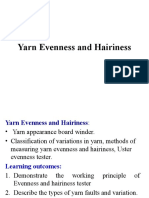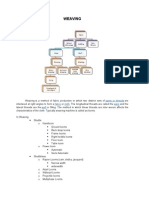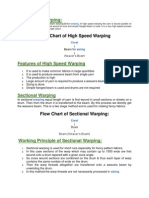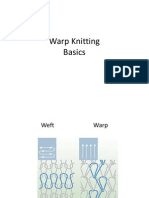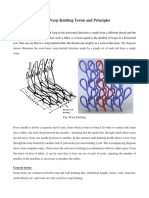0 ratings0% found this document useful (0 votes)
47 viewsShuttleless Loom
Shuttleless Loom
Uploaded by
vasineyvarious types of shuttle loom
Copyright:
© All Rights Reserved
Available Formats
Download as PPTX, PDF, TXT or read online from Scribd
Shuttleless Loom
Shuttleless Loom
Uploaded by
vasiney0 ratings0% found this document useful (0 votes)
47 views64 pagesvarious types of shuttle loom
Original Title
shuttleless loom
Copyright
© © All Rights Reserved
Available Formats
PPTX, PDF, TXT or read online from Scribd
Share this document
Did you find this document useful?
Is this content inappropriate?
various types of shuttle loom
Copyright:
© All Rights Reserved
Available Formats
Download as PPTX, PDF, TXT or read online from Scribd
Download as pptx, pdf, or txt
0 ratings0% found this document useful (0 votes)
47 views64 pagesShuttleless Loom
Shuttleless Loom
Uploaded by
vasineyvarious types of shuttle loom
Copyright:
© All Rights Reserved
Available Formats
Download as PPTX, PDF, TXT or read online from Scribd
Download as pptx, pdf, or txt
You are on page 1of 64
SHUTTLE LESS LOOMS
The weaving machines present following advantages
over traditional looms:
1. Total elimination of any spooling operation
2. Production increase, thanks to the fact that these
machines can work at high speed, owing to the
reduction or elimination of moving masses
3. Reduction of the shed size, therefore lower tension of
the warp threads and consequently reduction in the
number of yarn breaks
4. Noise reduction thanks to the elimination of the shuttle
pick
5. Automation of various devices.
CLASSIFICATION OF SHUTTELLESS LOOM:
Shuttleless looms are basically classified into two,
• Monophase and
• Multiphase depending on the method of weaving
technique.
The monophase loom is always of flatbed type while
multiphase may be flat or circular in construction.
Monophase:
• Normally in the shuttle or shuttleless looms, the three
primary motions; shedding, picking and beating occur
one after another in single phases.
• This means, the entire warp sheet is first formed into a
shed at a time, the pick of weft is then inserted all
through the shed and finally the entire length of the pick
is beaten at a time.
• This is known as monophase weaving.
Multiphase:
• In multiphase weaving, the three primary motions take
place concurrently in more than one phase at a given
time.
• In other words, the formation of the cloth takes place
continuously in small sections along the entire width or
length of the warp sheet.
• The example is circular weaving.
Classification
On the basis of the system used for weft insertion, the weaving
machines can be divided into:
A) Machines with mechanical weft insertion system:
by rigid rapiers
by flexible rapiers
by projectiles
B) Machines with non-mechanical weft insertion system:
by jets of compressed air
by jets of compressed water
Furthermore the machines can be divided into:
a) Mono-phase weaving machines (inserting one weft at a
time)
b) Multi-phase weaving machines (inserting several wefts at a
time)
Yarn quality requirements
• The tension on the warp on shuttleless
weaving machine is high
• Quality of yarn should be at least within 25 per
cent Uster which means the quality is among
the best 25 percent of the mills in the world
• shuttleless weaving machine works three to
four times faster
• Quality of warp remains the same, warp breaks
will increase three to four times resulting in
low production
Certain yarn parameters
– CV of count,
– Single Thread Strength,
– CV of single thread strength,
– Imperfections per 1,000 metres such as thick places,
thin places, and neps.
– Hairy yarn will not be suitable in air jet weaving as
it will misdirect the weft
insertion
• All medium and fine counts and all blended yarns
with polyester components should be wound on
automatic winding machines like Autoconer,
Murata, etc.
• Using electronic yarn clearer
• The size of the tail ends of knots should be small
• A large no of automatic winding machines are
equipped with knot/ splice tester which ensure 90-95
percent perfect joints
Quality levels of yarns during high speed warping
International norms for end breaks during high speed
Count warping
End breaks per million meter of
yarn
30s to 40s 0.65
0s to 60s 0.80
80s to 100s 1.0
Weft Preparation
• Weft insertion rate is high.
• Unwinding is intermittent on shuttleless
weaving machines.
• A hard wound packages is required.
• It is essential to have anti patterning device.
• Weft accumulators are to be used on high speed
weaving machines when the weft insertion rate
is above 1000 m/min.
Rapier Weaving Machine
A rapier loom is a shuttle less weaving loom in which
the filling yarn is carried through the shed of warp
yarns to the other side of the loom by finger-like
carriers called rapiers.
• Inventors
– Mr. Jahann Gabler – Father of modern technology,
he built a rapier device on cotton weaving machine
in 1922, Loop transfer technology
– Mr. Remond Dewas introduced a tip transfer
technology in 1939
• The rapier weaving machines are the most
flexible machines on the market.
• Their application range covers a wide variety
of fabric styles.
• Their present weaving speed of about 600-700
strokes/min is the result of the use of a state-of-
the-art construction technique, characterized by
the use of gear sets without plays and by
minimum vibrations of reed, slay and heald
frames.
• A rapier loom uses a rapier to pull the weft yarn
across the loom.
• It can be a single rapier or double rapier.
• For a single rapier, a long rapier device is required
to extend across the full width of warp.
• For a double rapier loom, two rapiers enter the
shed from opposite sides of the loom and transfer
the weft from one rapier head to the other near the
centre of the loom
• The advantage of two rapier system is only 50%
of the rapier movement is utilized in the weft
insertion of single rapier loom
Principle of Rapier weaving machine
• In Rapier weaving machines weft yarn is
inserted in the shed by positive driven weft
carrier heads.
• The carrier heads are attached to rapiers which
are flexible tapes or rigid rods.
Classification of rapier weaving machines
The rapier weaving machines are basically classified by the following
criteria.
Number of rapiers
– Single rapier
– Double rapier systems
Method of weft insertion
– Loop transfer
– Tip transfer
Type of rapier
– Rigid rapier
– Flexible rapier
Positioning of the rapier driving mechanism
– Rapier driving mechanism mounted with sley drive
– Rapier driving mechanism independent of sley drive
Working principles of various Rapier systems
Rigid Rapier System
• In rigid rapier system the Rapier heads are carried by rigid rods.
• These are thin – wall tubes approximately 10 to 15 mm diameter,
or sometimes hollow bars of rectangular cross section.
• The rigid rapiers need not be guided across the warp sheet.
• Only the rapier head slides on the warp, supported by a gib,
similar to the shuttle race on the automatic weaving machine.
• The disadvantage of the rigid rapier system is the larger floor
space required by the weaving machine (at least twice that of the
fabric width).
• Because the entire length of rapier has to be withdrawn on each
side of the loom.
• ..\TFM\TFM Videos\Unit IV\Rapier\Rapier.mpg
• ..\TFM\TFM Videos\Unit IV\Rapier\Rapier 2.mp4
Flexible Rapier System
• In flexible rapier system the flexible plastic or metal
bands (25 mm by 1 mm cross section) are used.
• The flexible rapiers have the tendency to buckle
during insertion into the shed.
• The floor space required by a weaving machine with
flexible rapiers is less.
• Because the flexible rapier when pulled out of the
warp is wound on to a wheel or folded in a semi-
circular channel at the machine side.
• So these flexible rapiers have to be usually guided
through the sheds by means of rapier guides attached
to the sley.
Insertion of double pick with single rapier
• Used in tape loom, axminister carpet loom
• Conventional selvedge is formed on the weft
supply side, other side secured by knitting or
catch cord
• No need to cut the weft
• No weft waste
• Constant rubbing between the yarn and rapier
eye
• Mechanism is simple
• Weft insertion speed is twice the speed of the
rapier insertion speed
Insertion of single pick with single rapier
• Weft is inserted either during rapier insertion or rapier
withdrawal
• The problem of weft transfer do not arise
• Normal range of fabric can be woven
• Rapier has either idle in backward or forward
movement
• Loom speed is very slow
• Weft insertion rate is 400 mpm
Two phase weft insertion
• Available in Saurer loom
• (width 2x185 cm or 2x220 cm)
• Weft insertion rate 1200 mpm
• Using rigid rapier, mounted at the centre of the two
machine
• Rapier has head at each end
• Maximum capacity of the heald is 14
• Floor space utilization and high weft insertion rate are
the advantages of this system
• Commercially not successful
Double rapier
Loop Transfer - Gabler System
• The rapiers A and B are about to enter the shed. The
weft is correctly positioned in front of the rapier head
by weft positioner. The free end of the weft is gripped
by weft gripper.
• The rapiers have entered the warp shed. The giver
rapier is drawing the weft thread in the form of loop.
At the centre of the shed both rapier heads meet and
the loop is transferred to the receiver rapier.
• Rapiers are withdrawn from the shed. Weft gripper
releases the weft yarn. At the same time a clamp
closes to stop the weft supply from supply package.
The weft loop is thus straightened by receiver rapier
and a complete pick is inserted.
• The right hand rapier is again advancing
towards the centre of the shed. The Weft
positioner presenting the weft to the giver
rapier. So the weft is carried in the form of loop.
At the centre of the shed the loop is transferred.
• Rapiers are withdrawn. On the right hand side
the weft yarn is detached by scissors. The loop
is straightened. So the second pick in this cycle
is inserted. On the right side the conventional
selvedge is formed.
• Weft is supplied from magazine cone weight
3-4 kg
• Weft is inserted by flexible rapier
• Hair pin selvedge at right hand side of the
loom
• Leno selvedge at left hand side of the loom
Tip transfer - Dewas system
• Weft positioner presenting the weft yarn to the right side giver
rapier, as it is advancing towards the centre of the shed.
• At this point the weft is still connected to the previous pick
and hence it is gripped. After catching by the giver rapier the
weft is cut by scissors.
• The free end of the weft (tip) is now carried by the giver
rapier in side the shed. At the centre of the shed the weft is
transferred from giver to receiver rapier.
• Rapiers are withdrawn. The receiver rapier carries the weft
yarn to the other side of the loom. And hence one complete
pick is inserted.
• After beating up this pick and after the giver rapier catches
the weft, the weft yarn is detached by scissors.
Rapier drives
Using grooved cams or matched cam
Main aims are
• To reduce the cost of manufacture
• To reduce the energy consumption
• To reduce the floor space
• To make it simple, durable and ease of maintenance
• To have a satisfactory noise level
• To make it versatile
In flexible rapiers are driven at both sides by shrouded
tape wheels
Tape wheel is driven by crank and rack and pinion
Crank is mounted on the driving shaft
Rigid Rapier Drive – Direct Eccentric
The direct eccentric arrangement is
used, which operates vertically in
double rapier machines.
But there is insufficient space from
the floor to the weaving height when
a full width single rapier is used.
So the eccentric is made to operate
horizontally under the warp sheet.
Here the driving arm is extended
from the back of the loom to the
rapier at the front.
In all instances, the driving head of
the rapier must follow a straight line,
so it is necessary for the driving arm
to oscillate on a pivot arm as shown
in the figure.
Flexible Rapier Drive – Somet Loom
Projectile Loom
• A number of projectiles is employed to insert the
picks.
• The projectile is a thin and light metal piece with 89
mm length, 14.3-15.8 mm width and 6.35-8.5 mm
thickness and weighs about 25-60g.
• It grips the tip of weft at its rear end and traverses
through the warp shed to insert the pick.
• In the projectile loom the projectile traverses from left
to right to pick the weft.
In projectile picking system more than one type of
weft can be used.
• Projectile looms of two manufacturers, Sulzer of
Switzerland and Textil mash (STB Loom) of Russia
are used in weaving jute fabrics.
• The principles of weft insertion and other operations
are identical in both the makes.
Projectile Picking System :
• In this type of weaving machine, picking is executed by
torsion bar.
• The mechanism is situated at the left hand side of the
loom.
• The picking cam fitted on the picking shaft rotates once
every pick and gradually displaces the toggle lever
about its pivot.
• The toggle lever is fastened at one end of the torsion bar
and at the other end the bar is fixed on the loom frame.
• The rotation of the picking cam twists the torsion bar
and strain energy is developed in it.
• During picking the energy is suddenly released and the
projectile is picked at a high velocity of about 24 m/sec .
Projectile :
• Size: 3.5 x 0.625 x 0.25 inch (79 x 16 x6 mm)
• Weight: 1.33 ozs (37 gm.) approximately
lighter (25 gm.)
• “K” Version - projectiles are larger & heavier
No. of Projectiles in Loom:
= 1 + 3 + (Reed Space in inch) / 10
= 1 + 3 + 90 / 10 = 13 when the Reed Space is
90 inch
1 in picking, 3 in receiving and 1 per 10 inch
reed space
Projectile Guide :
• The projectile is much lighter and traverses at much
higher velocity than shuttle.
• As a result, the projectile may be easily deflected
from its path by the slightest obstruction on its
passage.
• To avoid such possibility the projectiles are propelled
through a series of thin metal guides called the
projectile guides, mounted on the sley.
• The guides are spaced at intervals with their axial
planes in the warp direction and the warp is not
touched by the projectile or the weft.
• ..\TFM\TFM Videos\Unit IV\Projectile\Projectile Circulation.WMV
• ..\TFM\TFM Videos\Unit IV\Projectile\Projectile Weft Insertion.mpg
• During entire period of weft insertion the sley
remains stationary at back center.
• The projectile grips the weft with the help of
spring loaded grippers at its rear end and
traverses through the guides.
• As the projectile passes through the guides it
lays the weft inside the guides.
• When the sley moves forward to beat up the
weft slips out of each guide through its
aperture facing the reed and is beaten to the fell
of the cloth.
Insertion cycle of the projectile machine
• The schemes in Fig. show the insertion cycle of the
projectile machine:
a) The projectile 1 is put in launching position; the weft is
hold at its end by the weft carrier 2 and is controlled by
the weft tensioner 3, by the weft brake 4 and by the eyelet
7 situated in proximity of the feeding bobbin 8;
b) The weft carrier 2 gets open after the projectile clamp has
got hold of the end of the weft thread;
c) The projectile 1 is launched and crosses the shed dragging
with itself the weft, while the weft tensioner 3 and the
weft brake 4 operate in a way as to minimize the stress on
the yarn (the critical phases are particularly the initial
acceleration phase and the final stop phase in the collector
box);
• d) The projectile 1 on the one hand and the weft
carrier 2 on the other take up the right position to
build up the selvedge, while the tensioner arm
opens to adjust the weft tension;
• e) The weft carrier 2 closes while the selvedge
clamps 5 get hold of the weft thread on both
sides and the projectile clamp is opened to
release the weft end;
• f) The thread is cut by the scissors 6 on the
launching side, while the projectile 1 is placed in
the transport chain;
• g) The weft is beaten by the reed, while the
weft carrier 2 moves back to its initial position
and the weft tensioner 3 opens further to
recover the thread piece and to keep it under
tension. The projectile is brought back to the
launching zone;
• h) The selvedge needles 9 insert the weft ends
into the subsequent shed (tuck-in selvedge),
while a new projectile is placed in launching
position.
Beat up mechanism
You might also like
- BDS Catlogue PDFDocument298 pagesBDS Catlogue PDFShafiqul IslamNo ratings yet
- Yarn Eveness TesterDocument32 pagesYarn Eveness TestervasineyNo ratings yet
- Yarn Numbering System - CountDocument45 pagesYarn Numbering System - CountvasineyNo ratings yet
- Textile Chemical Processing 11Document64 pagesTextile Chemical Processing 11vasiney50% (2)
- 4 Point SystemDocument6 pages4 Point Systemapi-2649455589% (9)
- User Manual DigiBunai PDFDocument53 pagesUser Manual DigiBunai PDFDinesh Bhathela100% (1)
- Weaving RapierDocument22 pagesWeaving RapierSoundar VSNo ratings yet
- Rapier Weaving MachineDocument4 pagesRapier Weaving Machineਅਸ਼ਵਿੰਦਰ ਸਿੰਘNo ratings yet
- Loom TypesDocument32 pagesLoom Typeskhushikohli2626No ratings yet
- Rapierloom 161225095053 PDFDocument26 pagesRapierloom 161225095053 PDFAnonymous zycCPVvWj100% (1)
- MultiphaseDocument34 pagesMultiphaseakibhasan656100% (1)
- FM LLL PPTPresentation1air JetDocument12 pagesFM LLL PPTPresentation1air JetRaman KumarNo ratings yet
- Textile InternshipDocument51 pagesTextile InternshipPadmasri JeyakumarNo ratings yet
- Chapter Three: Rapier LoomsDocument27 pagesChapter Three: Rapier LoomsGadisa Abrahim100% (1)
- Draw FrameDocument50 pagesDraw FrameDev Narayan KushwahaNo ratings yet
- FM-III Unit 3Document72 pagesFM-III Unit 3Jjeerryyy NikharNo ratings yet
- TFM PresentationDocument31 pagesTFM PresentationWajeeha KzNo ratings yet
- Weaving MachinesDocument9 pagesWeaving MachinesManoja Samarasinghe100% (2)
- Woven Fabric Formation Technique - Part 1Document29 pagesWoven Fabric Formation Technique - Part 1ramstexNo ratings yet
- Weft KnittingDocument177 pagesWeft KnittingV B NagarajanNo ratings yet
- warpingDocument24 pageswarpingtakirumba027No ratings yet
- Chapter 1-3Document24 pagesChapter 1-3Mehmet AlNo ratings yet
- Knitting Machines Circular and FlatbedDocument13 pagesKnitting Machines Circular and Flatbedsonia.jha13290No ratings yet
- Study On Different Types of LoomDocument12 pagesStudy On Different Types of LoomEhsaan Raahi Rihaan0% (1)
- WeavingDocument41 pagesWeavingDeepthi channaNo ratings yet
- Lecture 6 WeavingDocument51 pagesLecture 6 Weavingabeeeha228No ratings yet
- WeavingDocument18 pagesWeavingKali Muthu100% (1)
- Arvind Textile Internship Report-Final 2015Document50 pagesArvind Textile Internship Report-Final 2015Divyanshu Sagar0% (1)
- 08 Wrap - YarnDocument39 pages08 Wrap - YarnShashwata BhowmikNo ratings yet
- Textile Internship Report AlokDocument39 pagesTextile Internship Report AlokRahul TelangNo ratings yet
- Chronological Development of LoomDocument17 pagesChronological Development of LoomAfjal Hossain SujanNo ratings yet
- Weaving: by S Naavendhan 20MT31Document124 pagesWeaving: by S Naavendhan 20MT3120MT31 - NAAVENDHAN SNo ratings yet
- Loom MotionsDocument5 pagesLoom MotionskowsalyaNo ratings yet
- 6.2 Assign 1-SNLS MachineDocument25 pages6.2 Assign 1-SNLS MachineAreef Khan100% (2)
- New Microsoft Office Word DocumentDocument15 pagesNew Microsoft Office Word DocumentS.m. MahasinNo ratings yet
- OverLock MachineDocument13 pagesOverLock MachineAhnaf ZahinNo ratings yet
- Rotor SpinningDocument4 pagesRotor SpinningJasmeet SinghNo ratings yet
- Feed of The Arm MachineDocument17 pagesFeed of The Arm Machinearushi.singhNo ratings yet
- Knitting Technology II: Lecture Note 12, 13 &14 Etsehiwot Yisma 2019Document16 pagesKnitting Technology II: Lecture Note 12, 13 &14 Etsehiwot Yisma 2019fekadeNo ratings yet
- JacquardDocument54 pagesJacquardvasineyNo ratings yet
- Warp Knitting MachineryDocument5 pagesWarp Knitting MachineryTextile AcademiaNo ratings yet
- High Speed WarpingDocument9 pagesHigh Speed WarpingShailendra MishraNo ratings yet
- SpinningDocument88 pagesSpinning0549 Pranjal NigamNo ratings yet
- Technical Knitted Fabric StructuresDocument32 pagesTechnical Knitted Fabric StructuresSujit GulhaneNo ratings yet
- Unit - 4 Flat Knitting & Warp KnittingDocument25 pagesUnit - 4 Flat Knitting & Warp Knittingsudharocky7868No ratings yet
- PPTDocument56 pagesPPTSomalika Banerjee100% (2)
- Shuttle Less Weaving Special PickingDocument44 pagesShuttle Less Weaving Special PickingAbdul AzizNo ratings yet
- Advancement in Weft InsertionDocument10 pagesAdvancement in Weft InsertionYared FikreNo ratings yet
- Fabric Manufacturing (Weaving)Document16 pagesFabric Manufacturing (Weaving)Muhammad SagheerNo ratings yet
- KnittingDocument2 pagesKnittingDato NJNo ratings yet
- Process Sequence of WeavingDocument55 pagesProcess Sequence of WeavingMehzabeen ShahidyNo ratings yet
- The Ring FrameDocument11 pagesThe Ring FrameMaham ButtNo ratings yet
- Weft Knitting MachinesDocument26 pagesWeft Knitting MachinesMAHFUZUR RAHMAN MAHFUZ0% (1)
- Oe & RS YarnDocument16 pagesOe & RS YarnrabiulfNo ratings yet
- Warp KnittingDocument22 pagesWarp KnittingvasineyNo ratings yet
- At Present There Is A Great Profusion of Types of Rapier Looms On The MarketDocument3 pagesAt Present There Is A Great Profusion of Types of Rapier Looms On The MarketDax ShuklaNo ratings yet
- Warp Knitting Basics1Document19 pagesWarp Knitting Basics1Gurwant Singh GillNo ratings yet
- Weaving TechnologyDocument47 pagesWeaving TechnologyMohammed shohag islam100% (3)
- WarpingDocument10 pagesWarpingKalyan Ray GuptaNo ratings yet
- Advanced Warp KnittingDocument15 pagesAdvanced Warp KnittingNazim Uddin RayhanNo ratings yet
- Fabric IV PPT MahasinDocument12 pagesFabric IV PPT MahasinS.m. MahasinNo ratings yet
- Weaving Technology 3rd Sem Unit - II DHTTDocument59 pagesWeaving Technology 3rd Sem Unit - II DHTTSANJIT JANANo ratings yet
- Warp Knotting Machine and Tying FrameDocument5 pagesWarp Knotting Machine and Tying FrameKhubab Shaker100% (2)
- Practical 01Document4 pagesPractical 01ali hasanNo ratings yet
- Complete Book of Sewing Techniques: More Than 30 Essential Sewing Techniques for You to MasterFrom EverandComplete Book of Sewing Techniques: More Than 30 Essential Sewing Techniques for You to MasterRating: 3 out of 5 stars3/5 (2)
- 3 Beautiful Bags: Exclusive extract from the forthcoming A Bag for All ReasonsFrom Everand3 Beautiful Bags: Exclusive extract from the forthcoming A Bag for All ReasonsNo ratings yet
- Warp KnittingDocument22 pagesWarp KnittingvasineyNo ratings yet
- Unit III DobbyDocument32 pagesUnit III DobbyvasineyNo ratings yet
- JacquardDocument54 pagesJacquardvasineyNo ratings yet
- Beat-Up MechanismDocument39 pagesBeat-Up MechanismvasineyNo ratings yet
- Non WovenDocument95 pagesNon WovenvasineyNo ratings yet
- Textile and Apparel Quality EvaluationDocument65 pagesTextile and Apparel Quality EvaluationvasineyNo ratings yet
- Flat Bed KnitingDocument21 pagesFlat Bed Knitingvasiney100% (1)
- FABRIC MANUFACTURE Two Marks Question With AnswerDocument12 pagesFABRIC MANUFACTURE Two Marks Question With AnswervasineyNo ratings yet
- Lab 2 - Weft Multicolor EffectDocument8 pagesLab 2 - Weft Multicolor Effectykz99gkrqgNo ratings yet
- Belt Conveyor DesignDocument21 pagesBelt Conveyor DesignAjith100% (3)
- Complete Solutions For Your Success in WeavingDocument24 pagesComplete Solutions For Your Success in WeavingSmita PatilNo ratings yet
- TEXTILE TESTING ProceduresDocument94 pagesTEXTILE TESTING ProceduresGopika G Nair0% (1)
- Embroidery Tools and MaterialsDocument25 pagesEmbroidery Tools and MaterialsRoderick Viloria Milo100% (1)
- 151023-02 KM WARP PREPARATION View PDFDocument24 pages151023-02 KM WARP PREPARATION View PDFDSSidgiddiNo ratings yet
- 8-9. WarpingDocument41 pages8-9. WarpingMd. Towfiq ImrozNo ratings yet
- NIFT Cluster InitiativesDocument15 pagesNIFT Cluster InitiativesShruti JhunjhunwalaNo ratings yet
- ASTM D4772 Water Absorption PaperDocument10 pagesASTM D4772 Water Absorption PaperGeorge Vekinis100% (1)
- 3 s2.0 B9781845697570500192 MainDocument9 pages3 s2.0 B9781845697570500192 MainDrWeaam AlkhateebNo ratings yet
- Fabric Powerpoint 19Document55 pagesFabric Powerpoint 19Japhet GatchoNo ratings yet
- Knitting LectureDocument8 pagesKnitting LectureTextile Academia100% (1)
- Kandanghi SareeDocument18 pagesKandanghi SareeHaja BasheerahamedNo ratings yet
- Art Form: Crafts As An Art Form Is An Outlet of Human Expression, Usually Influenced by Culture andDocument22 pagesArt Form: Crafts As An Art Form Is An Outlet of Human Expression, Usually Influenced by Culture andAryan RathoreNo ratings yet
- Effect of Pile Density On Physical Properties of Terry Towel FabricDocument4 pagesEffect of Pile Density On Physical Properties of Terry Towel FabricshobsundarNo ratings yet
- Valu Chain Analysis For Weaving ProductsDocument74 pagesValu Chain Analysis For Weaving Productsgizex2013100% (1)
- Gap Analysis RM AssignmentDocument24 pagesGap Analysis RM AssignmentAPOORVANo ratings yet
- TFM Lecture 12Document12 pagesTFM Lecture 12Muhammad Danish HabibNo ratings yet
- Kohinoor Grammar School: Q1 (A) Study Fig. 1 Which Shows The Different Processes Involved in Cotton Textile IndustryDocument3 pagesKohinoor Grammar School: Q1 (A) Study Fig. 1 Which Shows The Different Processes Involved in Cotton Textile IndustryAmnaNo ratings yet
- 18 July SynopsisDocument9 pages18 July SynopsisYashashree DeshmukhNo ratings yet
- Art of The Philippine WeavingDocument114 pagesArt of The Philippine WeavingMark100% (1)
- Report by Mary Grace I. ValilaDocument37 pagesReport by Mary Grace I. ValilaJocelyn GaniaNo ratings yet
- Basketry Quarter 1: Learner'S MaterialDocument27 pagesBasketry Quarter 1: Learner'S MaterialJesille May Hidalgo BañezNo ratings yet
- A Study On Representation of 3D Virtual Fabric Simulation With Drape Image AnalysisDocument15 pagesA Study On Representation of 3D Virtual Fabric Simulation With Drape Image AnalysisbeeyesyemNo ratings yet
- Medium and Techniques of Visual ArtsDocument15 pagesMedium and Techniques of Visual ArtsGoopio, Kisses C.No ratings yet
- Nurpur Silk Mills - New 5thsept2017Document25 pagesNurpur Silk Mills - New 5thsept2017Nurpur Silk Mills0% (2)
- Fabric TerminologyDocument20 pagesFabric TerminologyRasel MahmudNo ratings yet

